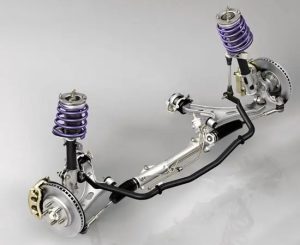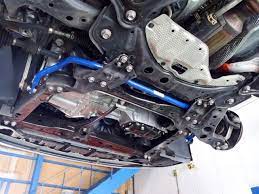Modifying your vehicle’s ride height — either by lowering it for better street performance or lifting it for off-road adventures — is a popular trend among automotive enthusiasts. However, few realize how much these changes affect the stabilizer bar, also known as the anti-roll bar or sway bar. This crucial suspension component plays a vital role in controlling body roll and maintaining stability during turns.
This article explores how changes in ride height influence the behavior of the stabilizer bar, what problems may arise, and how to correct them for optimal performance and safety.
What Is a Stabilizer Bar?

A stabilizer bar is a metal rod that connects the left and right sides of a vehicle’s suspension. It resists roll during cornering by distributing load forces from one side of the suspension to the other. In short, it keeps your vehicle flatter and more balanced when turning or maneuvering quickly.
Key Functions:
-
Minimizes body roll in corners
-
Improves high-speed stability
-
Enhances driver control during sharp maneuvers
How Ride Height Changes Affect the Stabilizer Bar
Altering your vehicle’s height changes the angles and leverage on many suspension components, including the sway bar. These geometric changes can reduce the bar’s effectiveness or even damage it or other suspension parts.
Lowering Your Vehicle:
Lowering a car reduces the distance between the chassis and suspension components.
Common Effects:
-
Increased preload on sway bar: Causes the bar to always be slightly twisted, affecting ride comfort and performance
-
Limited articulation: The bar may bind or come into contact with other parts
-
Reduced handling precision: Altered geometry affects sway bar leverage
Lifting Your Vehicle:
Lifting a vehicle increases suspension travel and separation between components.
Common Effects:
-
Reduced sway bar engagement: The bar may not activate until the vehicle has leaned significantly
-
Extended end link angles: Can overstretch or break the sway bar links
-
Excessive body roll: Especially on tall, top-heavy vehicles
Comparison Table: Effects of Ride Height on Stabilizer Bars
| Modification Type | Ride Height Change | Main Effects on Sway Bar | Recommended Fix |
|---|---|---|---|
| Mild Lowering | −25 mm to −50 mm | Slight preload, mild geometry shift | Adjustable or shorter end links |
| Aggressive Lowering | > −50 mm | Binding, reduced articulation, preload | Performance sway bar + custom links |
| Mild Lift | +25 mm to +50 mm | Decreased sway bar leverage | Extended end links |
| Extreme Lift | > +50 mm | Minimal sway bar action, link stress | Sway bar disconnects or drop kits |
End Links: The Forgotten Connection
Sway bar end links connect the stabilizer bar to the suspension arms or struts. When lowering or lifting a vehicle, these links often become misaligned or operate at suboptimal angles.
Problems Caused by Incorrect End Links:
-
Clunking or knocking noises
-
Premature wear or breakage
-
Uneven handling or increased body roll
Solution: Always use adjustable or vehicle-specific end links when modifying ride height.
When to Consider Aftermarket Stabilizer Components
Lowered or lifted vehicles often benefit from upgraded sway bars and accessories to restore suspension performance. These include:
Recommended Components:
-
Adjustable sway bar end links: Maintain correct angle and preload
-
Heavy-duty sway bars: Reduce roll in lifted vehicles
-
Quick disconnects: Allow off-roaders to disengage sway bars for better articulation
-
Polyurethane bushings: Improve response and reduce wear
Driving Performance: What to Expect
Changing your ride height without adjusting your sway bar setup can lead to unpredictable handling. Here’s what you might notice:
| Symptom | Likely Cause | Solution |
|---|---|---|
| Increased body roll | Sway bar out of alignment | Re-align or upgrade bar/components |
| Clunking during turns | Worn or overstretched end links | Replace with proper-length links |
| Harsh or uneven ride | Bar preload due to lowering | Use shorter/adjustable end links |
| Ineffective sway control | Lifted ride height + stock bar | Use extended links or larger bar |
Tips for Stabilizer Bar Setup After Modifying Ride Height

-
Check angles: After changing suspension height, inspect sway bar and end link angles at rest.
-
Upgrade components: OEM sway bars and links may not handle altered geometry well.
-
Re-torque bolts: After installation and driving a few miles, re-check torque settings.
-
Balance front and rear: If you upgrade one sway bar, consider matching it at the other end.
Conclusion: Stability Starts with the Right Setup
Whether you’re building a low-slung tuner or a trail-ready truck, proper stabilizer bar configuration is essential to maintain safe and responsive handling. Lowering a car too much without adjusting end links or sway bar preload can ruin comfort and stability. Conversely, lifting a vehicle without addressing sway bar function can cause dangerous body roll and control issues.
Always check your suspension geometry after modifying ride height — and invest in quality components that match your build.
Buy Stabilizer & Components online — Browse a wide selection of sway bars, end links, bushings, and accessories tailored to both lowered and lifted vehicles.